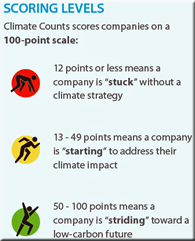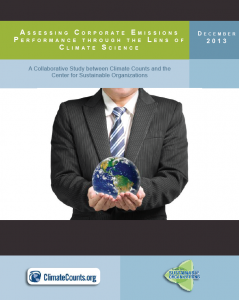 T’was a dark and stormy eve in January 2006, when legendary yogurt icon Gary Hirshberg, founder of Stonyfield Farm, conceived of a new way of doing things; a new way of shopping that reduced the amorphous concept of climate change to a simple scorecard; a barometer indicating the good and bad corporate actors such as Nike, McDonald’s, Hilton, Danone, Sony and over 150 other internationally recognized brands.
T’was a dark and stormy eve in January 2006, when legendary yogurt icon Gary Hirshberg, founder of Stonyfield Farm, conceived of a new way of doing things; a new way of shopping that reduced the amorphous concept of climate change to a simple scorecard; a barometer indicating the good and bad corporate actors such as Nike, McDonald’s, Hilton, Danone, Sony and over 150 other internationally recognized brands.
Using an easy-to-use 100-point scorecard, consumers could distinguish the best companies from the worst as easily as identifying colors of a stop light: Stuck companies (0-12 points), Starting (13 – 49 points), and Striding (50-100 points).
While the ‘climate shopping guide’ developed by Climate Counts gained international acclaim in the early days by the likes of the Wall Street Journal, Oprah Winfrey and the Economist, the ability to track its impact on consumer buying habits proved challenging. Adding to the challenge was a host of other issues including: a) disinformation campaign spearheaded by far-right groups such as the Heritage Foundation and other Koch Brother-backed efforts to thwart progress on addressing climate change (watch this video), and 2) the fact that Vice President Al Gore had become a vocal centerpiece of climate activism. Takend together and we have a glimpse into why climate change has become a lightning rod for partisan politics in America while the world around us (195 countries to be specific) have already come to terms with the long-term implications of this global phenomenon of climate change by ratifying the Paris Climate Accord.
Legacy Reports and Findings of Climate Counts:
 The world’s first Context-Based Sustainability Company Rating (December 2013)
The world’s first Context-Based Sustainability Company Rating (December 2013)
Science tells us that our planet is warming and that society is playing a big role, largely from the burning of fossil fuels. This phenomenon is a byproduct of the demands of a modern world. People need jobs and people need stuff, which means that we rely heavily on our global economy to produce the clothes we wear, the food we eat, and the energy required to power our homes. In essence, it is our reliance on industry and economic prosperity that makes addressing climate change so complex.
Our goal with this study is to take what we know about climate science and apply it to what we know about the current state of corporate greenhouse gas (GHG) emissions as a means of informing a pathway forward. What follows in the pages of this study is the result of several months of research to determine the answer to a single question: What progress is global industry making toward reducing its impact on climate change? Since 2007, Climate Counts has been rating companies annually on their commitment to address climate change. We have done this by assessing how companies measure, reduce and report their efforts to reduce GHG emissions. For this study, however, we are attempting something radically different. Instead of rating companies on the policies and procedures they have implemented to reduce carbon dioxide and other GHG emissions, we are rating them on their actual emissions performance relative to science-based targets. Thanks to the work of the science community, we now have a sense of what it would take to limit climate change to 2o Celsius (3.6o Fahrenheit). And thanks to the increasing transparency in the private sector to disclose emissions information, we now have the ability to gauge corporate progress against sciencebased targets — targets that provide a road map for us to work toward to ensure that future generations are afforded the same opportunities to enjoy our planet as we have. Climate change has presented us with a challenge, the likes of which has not been seen since the dawn of humanity. How we respond to this challenge as a society is being determined now. We hope you will walk with us as we attempt to carry the ball forward.
